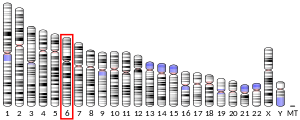KCNK16
Potassium channel subfamily K member 16 is a protein that in humans is encoded by the KCNK16 gene.[4][5] The protein encoded by this gene, K2P16.1, is a potassium channel containing two pore-forming P domains.[4][5]
| KCNK16 | |||||||||||||||||||||||||
|---|---|---|---|---|---|---|---|---|---|---|---|---|---|---|---|---|---|---|---|---|---|---|---|---|---|
| Identifiers | |||||||||||||||||||||||||
| Aliases | KCNK16, K2p16.1, TALK-1, TALK1, potassium two pore domain channel subfamily K member 16 | ||||||||||||||||||||||||
| External IDs | OMIM: 607369 MGI: 1921821 HomoloGene: 75328 GeneCards: KCNK16 | ||||||||||||||||||||||||
| |||||||||||||||||||||||||
| Orthologs | |||||||||||||||||||||||||
| Species | Human | Mouse | |||||||||||||||||||||||
| Entrez | |||||||||||||||||||||||||
| Ensembl |
| ||||||||||||||||||||||||
| UniProt | |||||||||||||||||||||||||
| RefSeq (mRNA) | |||||||||||||||||||||||||
| RefSeq (protein) | |||||||||||||||||||||||||
| Location (UCSC) | Chr 6: 39.31 – 39.32 Mb | n/a | |||||||||||||||||||||||
| PubMed search | [2] | [3] | |||||||||||||||||||||||
| Wikidata | |||||||||||||||||||||||||
| |||||||||||||||||||||||||
See also
- Tandem pore domain potassium channel
References
- GRCh38: Ensembl release 89: ENSG00000095981 - Ensembl, May 2017
- "Human PubMed Reference:". National Center for Biotechnology Information, U.S. National Library of Medicine.
- "Mouse PubMed Reference:". National Center for Biotechnology Information, U.S. National Library of Medicine.
- Girard C, Duprat F, Terrenoire C, Tinel N, Fosset M, Romey G, Lazdunski M, Lesage F (Mar 2001). "Genomic and functional characteristics of novel human pancreatic 2P domain K(+) channels". Biochem Biophys Res Commun. 282 (1): 249–56. doi:10.1006/bbrc.2001.4562. PMID 11263999.
- Goldstein SA, Bayliss DA, Kim D, Lesage F, Plant LD, Rajan S (Dec 2005). "International Union of Pharmacology. LV. Nomenclature and molecular relationships of two-P potassium channels". Pharmacol Rev. 57 (4): 527–40. doi:10.1124/pr.57.4.12. PMID 16382106.
Further reading
- Mungall AJ, Palmer SA, Sims SK, et al. (2003). "The DNA sequence and analysis of human chromosome 6". Nature. 425 (6960): 805–11. doi:10.1038/nature02055. PMID 14574404.
- Strausberg RL, Feingold EA, Grouse LH, et al. (2002). "Generation and initial analysis of more than 15,000 full-length human and mouse cDNA sequences". Proc. Natl. Acad. Sci. U.S.A. 99 (26): 16899–903. doi:10.1073/pnas.242603899. PMC 139241. PMID 12477932.
- Goldstein SA, Bockenhauer D, O'Kelly I, Zilberberg N (2001). "Potassium leak channels and the KCNK family of two-P-domain subunits". Nat. Rev. Neurosci. 2 (3): 175–84. doi:10.1038/35058574. PMID 11256078.
- Han J, Kang D, Kim D (2003). "Functional properties of four splice variants of a human pancreatic tandem-pore K+ channel, TALK-1". Am. J. Physiol., Cell Physiol. 285 (3): C529–38. doi:10.1152/ajpcell.00601.2002. PMID 12724142.
- Gierten J, Ficker E, Bloehs R, et al. (2008). "Regulation of two-pore-domain (K2P) potassium leak channels by the tyrosine kinase inhibitor genistein". Br. J. Pharmacol. 154 (8): 1680–90. doi:10.1038/bjp.2008.213. PMC 2518462. PMID 18516069.
External links
- KCNK16+protein,+human at the US National Library of Medicine Medical Subject Headings (MeSH)
This article is issued from Wikipedia. The text is licensed under Creative Commons - Attribution - Sharealike. Additional terms may apply for the media files.

